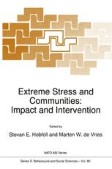Search
Search Results
-
Foundations for Parent—Child Interaction Therapy
“I love my child, but I just don’t like him very much.” This common sentiment was expressed by the frustrated and guilt-ridden mother of a...
-
Prevention of the Consequences of Man-Made or Natural Disaster at the (Inter)National, the Community, the Family and the Individual Level
It is possible by definition to prevent a posttraumatic stress syndrome by eliminating the traumatic event or by reducing its consequences. However,...
-
Intervention Strategies for Emergency Response Groups: A New Conceptual Framework
Emergency responder groups now encompass a broader variety of expert professionals and organizations than our local police, firebrigades, health care...
-
Measuring patient violence in dangerousness research
Research on the dangerousness of mental patients has paid only limited attention to the issues surrounding the measurement of violent events. This...
-
Co** with Relational Dissolutions: Attributions, Account Credibility, and Plans for Resolving Conflicts
In this chapter we will review the different types of studies we have completed concerning how people cope with deteriorating relationships. First,...
-
Toward a Deeper Understanding of Close Relationships
Social psychology has, somewhat belatedly, come to recognize the importance of close, long-term relationships between individuals (e.g., Argyle &...
-
Common Variables
Some lives show remarkable consistency. The unruly, obstreperous child, whose parents have a hard time managing, may develop into the hard-core...
-
Young Adult Cohorts
The life-span segments covered by the 15- and 18-year-old cohorts encompass many important developmental transitions, particularly in social and...
-
Support and Maintenance-When, How Much, and How Long?
While other issues may sometimes generate more emotional heat and energy, the question of support is perhaps the most complex with which the mediator...
-
Third Party Consultation as a Method of Intergroup and International Conflict Resolution
The ubiquitous phenomenon of intergroup conflict has a built-in tendency to escalate, as indicated in the eclectic model and as substantiated by a...
-
Conclusions and Future Directions
From the foregoing review of family measurement procedures, one conclusion should be clear—the domain is characterized by a great diversity of...
-
Natural Histories of Conduct Problems, Delinquency, and Associated Substance Use
In the past, distinctions between subclasses of conduct problems and delinquency were a matter of dispute among scholars in juvenile delinquency and...
-
Gender, sex roles, and attitudes toward war and nuclear weapons
The observation that men are usually more supportive of war than women had led several authors to suggest that masculinity plays a causal role in the...
-
Behavioral Assessment A New Theoretical Foundation for Clinical Measurement and Evaluation
With proper measurement being so important for the progress of any scientific discipline, it is difficult to imagine behavior therapy develo** in...
-
Introduction
Some of the most prominent lines of social-psychological inquiry have stemmed from researchers’ observations of significant (indeed, sometimes...
-
The Psychological Process of Entrapment
The preceding chapters have described the results and implications of studies exploring the social and nonsocial antecedents of entrapment. In...
-
The Role of Self-Presentation in Entrapment
A variety of social-psychological factors may influence people’s tendency to escalate commitment to a failing course of action. Three such factors...
-
Behavioral Marital Therapy
The emergence of behavioral marital therapy, approximately 13 years ago, drew attention primarily for the innovative and distinctive treatment...
-
Solving Special Problems
Throughout this guide we have described a variety of techniques or strategies for treating troubled relationships. Our experience and research have...
